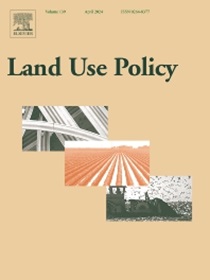中国西部云南农民工的土地权利、资源配置和城市定居选择
IF 5.9
1区 社会学
Q1 ENVIRONMENTAL STUDIES
引用次数: 0
摘要
本研究利用2015年和2021年云南农民工城市融入调查的横截面数据,评估了农民工在农村老家拥有的三种土地权对其在中国西部云南城市定居选择的不同影响。具体而言,本研究考察了在中国经济发展水平较低、农民工数量增长最快的西部地区,农民工因土地权对农民工的重要性而在城乡之间流动的情况。在控制了其他变量的影响后,我们使用多项式 Probit 模型估计了农民工在农村家乡的土地权对其在城市地区定居选择的影响。我们发现,农村土地权益明显提高了农民工的返乡意愿。这表明,土地权保障是影响云南农民工城市定居意愿的关键因素,尽管它在年龄组和原籍地方面是有条件的。重要的是,我们发现中国西部地区的农民工更倾向于保持他们作为城市农民工和农村居民的双重身份。因此,他们更倾向于在城乡之间合理分配资源,以实现经济产出的最大化。尤其是,他们更倾向于只在城市工作--而不是定居--,同时保留农村土地作为资产和收入来源。而迁移到经济欠发达的小城市的老年农民工则更倾向于在城市和农村地区之间漂泊,而不是在城市或农村地区定居。这印证了生计资源最大化和候鸟式迁徙是土地权属影响农民工城市定居意愿的重要机制。本研究建议,政策制定者在制定城市定居政策时应考虑农民工的土地权属,尤其是在农民工定居意愿较弱的中小城市。决策者还应促进农村土地使用权的灵活流转,探索三权分置改革,以实现城市化与土地使用效率之间的平衡,尤其是在中小城市。本文章由计算机程序翻译,如有差异,请以英文原文为准。
Land rights, resource allocation and urban settlement choices of migrant workers in Yunnan, Western China
Using the cross-sectional data from the 2015 and 2021 Yunnan Migrant Workers Urban Integration Survey, this study assesses the different effects of the three types of land rights that migrant workers possess in their rural hometowns on their urban settlement choices in Yunnan, western China. Specifically, it examined the existence of migrant workers moving between urban and rural areas in response to the importance of land rights for rural migrant workers, in western China, a region with the lower level of economic development and fastest growing number of migrant workers in China. After controlling for the impact of other variables, the multinomial Probit model was used to estimate the impact of the migrant workers' land rights in their rural hometowns on their settlement choices in urban areas. We found that rural land rights significantly increased migrant workers' willingness to return to their hometowns. This indicates that land right security is a key factor affecting Yunnan migrant workers' urban settlement intentions, although it is conditional in terms of age groups and places of origin. Importantly, we found that migrant workers in western China are more inclined to keep their dual identities as both urban migrant workers and rural residents. They, hence, are more inclined to rationally allocate their resources between urban and rural areas to maximize their economic outputs. Particularly, they prefer to only working - rather than settling - in urban areas, while retaining their rural land as assets and income sources. Instead of settling in either urban or rural areas, the older migrant workers who migrate to smaller and economically underdeveloped cities are more inclined to drift between urban and rural areas without permanent settlement. This confirms the argument of livelihood resource maximization and migratory bird-type migration as important mechanisms via which land right ownership affects migrant workers’ urban settlement intentions. This study suggests that policymakers should consider the land rights of rural migrant workers when making urban settlement policies, especially for small and medium-sized cities, where migrant settlement intention is weaker. Policymakers should also promote the flexibility of rural land use rights transfer and explore reforms concerning the separation of the three types of land rights to achieve a balance between urbanization and land use efficiency, particularly in small and medium-sized cities.
求助全文
通过发布文献求助,成功后即可免费获取论文全文。
去求助
来源期刊

Land Use Policy
ENVIRONMENTAL STUDIES-
CiteScore
13.70
自引率
8.50%
发文量
553
期刊介绍:
Land Use Policy is an international and interdisciplinary journal concerned with the social, economic, political, legal, physical and planning aspects of urban and rural land use.
Land Use Policy examines issues in geography, agriculture, forestry, irrigation, environmental conservation, housing, urban development and transport in both developed and developing countries through major refereed articles and shorter viewpoint pieces.
 求助内容:
求助内容: 应助结果提醒方式:
应助结果提醒方式:


